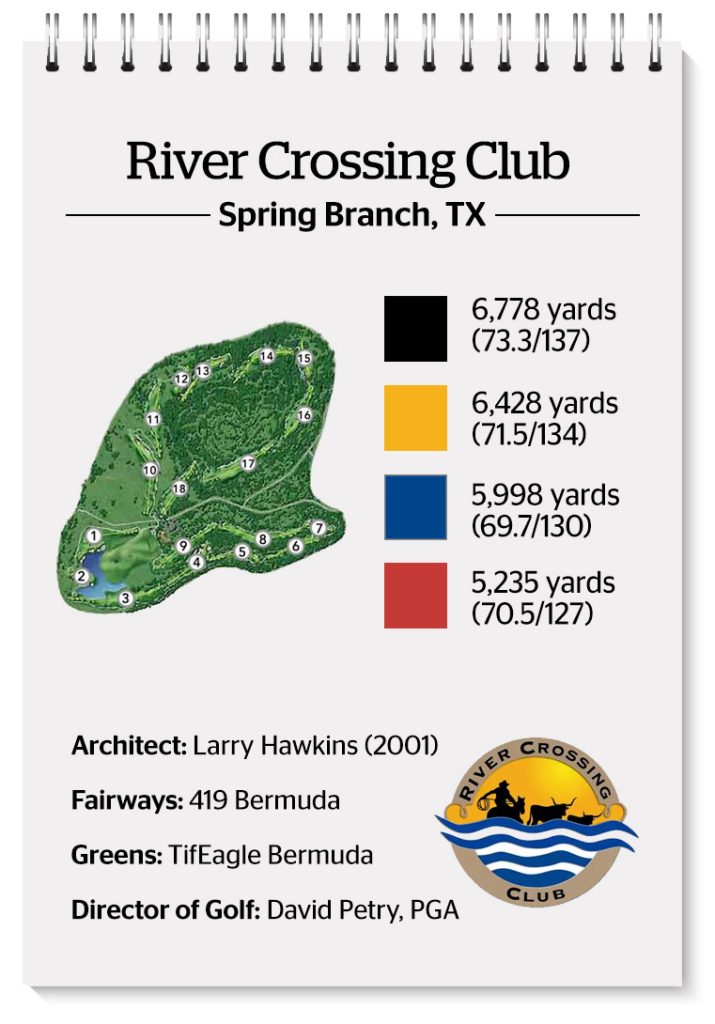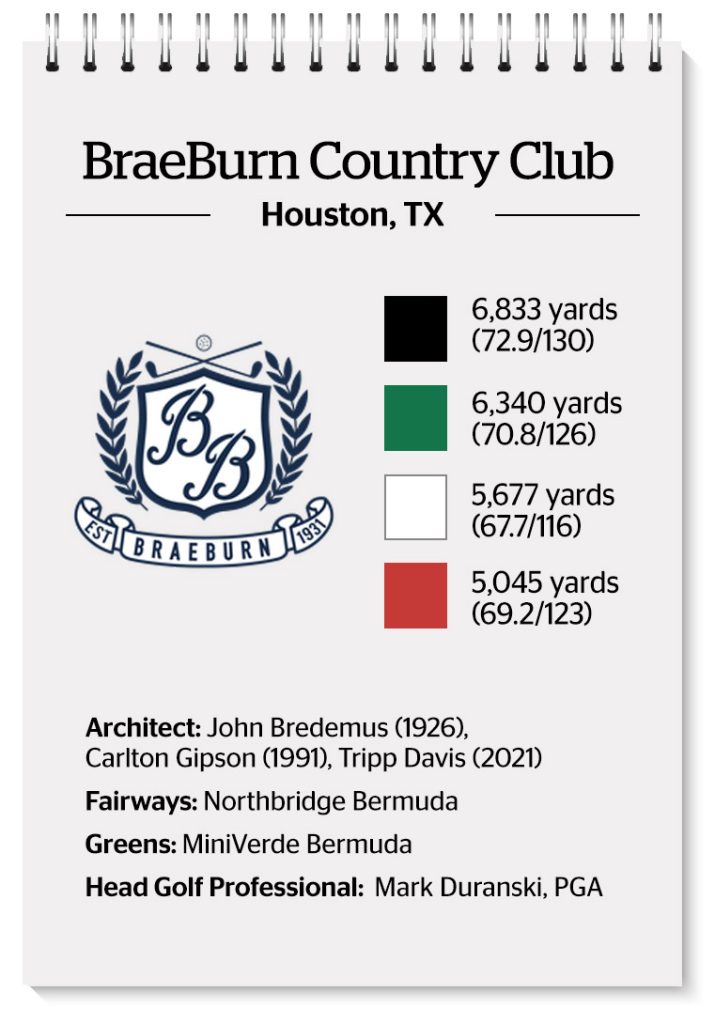Around the Green
The latest golf-related news, notes, and feature stories from the TGA.
River Crossing Club
River Crossing Club in Spring Branch, located about 20 miles north of San Antonio, is a picturesque retreat from the everyday hustle and bustle where members and guests can enjoy an assortment of exceptional recreational and social activities with an emphasis on golf.
Nestled against the backdrop of the scenic Texas Hill Country, River Crossing opened in 2001 with an 18-hole championship course designed by Larry Hawkins.
Though part of a large master-planned community, the course has very little intrusion of development other than an occasional house peeking out through the trees. The clear and unobstructed playing sightlines create a sense of openness and flow that feels larger and more inviting.
Hawkins expertly used the innate features of the property to produce an engaging routing that traverses across gentle rolling terrain and up and down over moderate elevation changes. There is wonderful variety at River Crossing, with holes moving in each direction and a mix of wide-open tee shots and others that are quite narrow. There are split-level fairways, a drivable downhill par 4, par 3s that range from pitching wedge to long iron, and an exciting closing stretch that includes two reachable par 5s. The green complexes are large and well bunkered, and their undulating surfaces demand a delicate, yet determined touch.
By offering five sets of tees to choose from, ranging in length from 6,788 yards to 5,235 yards, golfers of all ages and skill levels will find the par-72 layout to be an enjoyable challenge. And with a well-deserved reputation for having some of the best course conditions in the San Antonio area, along with its comfortable and relaxed setting, a round at River Crossing is sure to provide a truly memorable experience.
In addition to golf, the club has many other first-class amenities including state-of-the-art practice facilities and teaching academy, newly remodeled clubhouse and pro shop, well-equipped fitness center, casual and fine dining options, and an outdoor family activity area with a resort-style pool and rock slide waterfall.
The TGA will be heading to the beautiful River Crossing Club this spring for the 26th Women’s Partnership Match Play, scheduled for April 15-17. Entries for the Partnership are open to two-player teams of female amateur golfers with a certified WHS Handicap Index®. The starting field is divided into six flights based on team combined handicap indexes and the format is 45 holes of Round Robin Net Four-Ball Match Play. Tournament registration opens on Feb. 21 and will close on April 3.
For more information about River Crossing Club, click here. For more information about the 2024 Women’s Partnership Match Play, click here.

Around the Green
The latest golf-related news, notes, and feature stories from the TGA.
Major Motivation
The biggest amateur championships in Texas are getting bigger.
Texas Golf Association and Legends Junior Tour majors have always loomed large on the annual schedule. They are the marquee events that mean the most to players, the ones where the atmosphere is a little more charged and the nerves a little twitchier from the get-go. And now the intensity factor is about to be ratcheted up to another level with national championship exemptions also on the line.
Beginning in 2024, the United States Golf Association (USGA) will award exemptions to four of its premier amateur championships to the winners of the Texas Amateur, Women’s Texas Amateur, and Texas Junior Amateur (Boys and Girls 15-18 Divisions). The TGA and LJT state champions will earn exemptions from qualifying for their respective national championships, including the U.S. Amateur, U.S. Women’s Amateur, U.S. Junior Amateur, and U.S. Girls’ Junior.
The USGA’s decision to award these exemptions is based on starting field rankings for the three TGA and LJT events over the last three years. The fields for the select Texas events have proven to be some of the strongest among the country’s leading golf associations’ statewide competitions of a similar nature.
“We are truly appreciative of the USGA extending national exemptions to the winners of our longest-running majors and we are thrilled for our champions to receive them,” said Kevin Porter, the TGA’s Director of Competitions for North Texas. “This is a fantastic additional championship enhancement for our players, and we look forward to seeing them compete for this amazing opportunity.”
John Cochran IV, TGA Director of Competitions for South Texas, added, “The TGA and LJT majors annually boast highly competitive fields featuring hundreds of talented amateurs from across the state. For our players to now have the opportunity to earn exemptions into some of the USGA’s most historic championships is very exciting.”
Proving just how deep the amateur golf talent pool is in Texas, a number of recent USGA national champions have come from the TGA and LJT ranks, including Jordan Spieth (2009, 2011 U.S. Junior and 2015 U.S. Open), Kelly Kraft (2011 U.S. Amateur), Scottie Scheffler (2013 U.S. Junior), Will Zalatoris (2014 U.S. Junior), Kristen Gillman (2014, 2018 U.S. Women’s Amateur), and Sam Bennett (2022 U.S. Amateur).
Even if the USGA exemptions weren’t part of the equation, the slate of outstanding courses hosting this year’s TGA-LJT majors already had players eagerly awaiting the start of the season.
“We are excited to have such a great lineup of major championship sites on the schedule for 2024,” Porter said. “The players will have an opportunity to prove themselves at some of the state’s most esteemed venues, and we are grateful to our host member clubs for supporting our championships and adding to the rich golf history in Texas.”
Among the iconic host clubs this year are Lakewood Country Club in Dallas (LJT 25th Veritex Bank Byron Nelson Junior, June 4-6), Trinity Forest Golf Club, also in Dallas (115th Texas Amateur, June 13-16), Spanish Oaks Golf Club in Bee Cave (103rd Women’s Texas Amateur, June 25-28), The Clubs of Kingwood in Kingwood (98th Texas Junior Amateur, July 29-31), BraeBurn Country Club in Houston (49th Texas Four-Ball, Aug. 23-25), and The Nelson Golf & Sports Club in Irving (87th Texas Senior Amateur, Sept. 27-29).
The players won’t be waiting long for the action to start as the 2024 TGA-LJT major season is immediately busy and will begin Feb. 17-19 with the 15th Texas Girls’ Invitational at Eagle’s Bluff Country Club in Bullard. The opening tee shot at Eagle’s Bluff will officially kick off the first of ten majors over an eight-month stretch that will continue a long-standing tradition of excellence where the best of the best come together to showcase their skills and realize their dreams.
Over the next several pages, we’ve highlighted the courses and dates for each of these highly anticipated events that are sure to provide plenty of excitement this season. To view the full calendar of events for men, women and juniors, click on any of the following links: 2024 Men’s Schedule, 2024 Women’s Schedule, 2024 Legends Junior Tour Schedule.
Around the Green
The latest golf-related news, notes, and feature stories from the TGA.
Frost Delays: 5 Things Every Golfer Should Know
By USGA Green Section
While much of the U.S. deals with winter’s brunt, golfers in the Sun Belt and other mild parts of the country are still playing away. However, cool, crisp mornings bring the risk of frost delays. At some golf courses frost delays are rare, while at others they may be a regular occurrence. How often your morning round is affected by frost depends on the weather and a variety of other factors. Here are five things every golfer should know about frost delays:
1. Crunchy grass is vulnerable to damage.
Golf course turf is normally resilient to traffic, but when ice crystals form inside the plants, they become brittle and vulnerable to damage. Walking or driving over frost-covered grass may rupture plant cells, leading to dead turf. Or the plants may be weakened without immediately showing the effects. It can take grass more than a month to recover from this damage.
2. When it comes to frost delays, location is everything.
Many of us have looked out our windows at home and seen no signs of frost, only to find a frost delay when we reach the golf course. This is because frost can linger in colder microclimates long after other areas have thawed. North-facing slopes, low-lying areas and areas sheltered from the wind are especially likely to remain covered with frost. If you are worried about a potential frost delay it is best to call the golf shop to check on conditions at the course before leaving home.
3. Closely mown turf is at high risk.
Frost damage can occur on any part of the golf course, but it poses the greatest risk to closely mown turf. Putting greens are particularly vulnerable because they experience the most concentrated traffic. A foursome typically takes 300 steps or more on each putting green; if there is frost present, all those steps could cause serious damage.
4. A little frost can cause big delays.
No signs of frost on the first tee? That doesn’t mean you will get the “all clear” sign. If frost remains in areas that are unavoidable early in the round, the course must remain closed. It is also important to remember that once the frost is totally clear, the maintenance staff will need time to catch up on course preparations before play can begin.
5. More light goes a long way.
Shade extends frost delays by preventing sunlight from melting the frost. Pruning or removing trees that shade primary playing surfaces can improve the course’s overall health and reduce the duration of frost delays. This is especially true on holes played early in the round. The shade from a few trees can keep an entire course closed.
Around the Green
The latest golf-related news, notes, and feature stories from the TGA.
BraeBurn Country Club to Host Five Future TGA Championships
BraeBurn Country Club in Houston has been chosen by the TGA as the host site of five future TGA championships in the coming years: the 2024 Texas Four-Ball, 2025 Women’s Senior Stroke Play, 2026 Texas Senior Amateur, 2030 Texas Mid-Amateur, and the 2032 Texas Amateur.
Next year’s Texas Four-Ball will be the third TGA championship held at the club, which previously hosted the 1995 Texas Amateur, won by Brad Elder, and the 2005 Texas Mid-Amateur Match Play, won by Steve Gill.
“The TGA is thrilled to reunite with BraeBurn Country Club after nearly two decades and continue to build upon a partnership that will support amateur competition in Texas,” said John Cochran IV, TGA Director of Competitions, South Texas. “We are confident that the club’s rich history, illustrious course, and superb amenities will not only test the greatest players from around the state but also create a welcoming atmosphere for each of the five championships.”
Located on the southwestern edge of downtown Houston, BraeBurn Country Club is one of the oldest private clubs in the city. Originally founded in 1926 as the Colonial Country Club, BraeBurn was designed by renowned architect John Bredemus. In 1929, a group of investors led by Jack Burke, Sr., Bredemus, and Sid Van Ulm purchased Colonial Country Club from the original developer and after restructuring later reopened as BraeBurn Country Club in 1931.
The course has been updated several times throughout the years, with a major remodel overseen by Tripp Davis and Associates in 2021. During the recent modernization project, Davis and his team rebuilt and reshaped all the tees, greens, and bunkers to significantly enhance and fortify the strategic elements of Bredemus’ classic design.
“In the past decades, we have had such a rich history of golf here, that we would like to continue upon that tradition,” said Mark Duranski, Head Golf Professional at BraeBurn. “With the renovation in 2021 taking place, we’ve realized what a gem this golf course is. We can now create a very challenging setup despite the fact that it’s currently just under 7,000 yards. We know that we have an excellent tournament style course and want to promote its reputation as such.”
The club’s established tradition of promoting professional and amateur competitions includes hosting the 1950 Houston Open, 1952 LPGA Houston Weathervane, 1954 NCAA National Championship, and the 1988 Miracle Network Golf Tournament.
With a past list like that, it was only a matter of time before BraeBurn returned to the spotlight.
“We like to roll out the red carpet for all of our members and guests,” Duranski said. “When players come to BraeBurn for a tournament, we want them to feel welcome. That’s the kind of experience that we want to put forward for the golfers in the state that are going to come compete in these events.”
BraeBurn has long been known as a shot-maker’s course because of the predominance of trees, twisting fairways, and well-guarded greens. It will test the best amateurs in the state by making them utilize every tool in their arsenal as they wind through the parkland-style layout.
“From a golfing standpoint, the changes made can create a variety of different types of shots that players will have to hit,” Duranski said. “Players must execute every shot whether it’s from the tee, an approach shot, or around the greens. Plus, our par 3s give us lots of variability in distance, allowing us to create some fun and interesting angles.”
BraeBurn Country Club is certain to be a fantastic host for some of the TGA’s most high-profile events, culminating with the 2032 Texas Amateur. It presents a wonderful opportunity for players to compete on an esteemed course like BraeBurn, and there’s no better way to conclude the memorable five-championship lineup than with the most prestigious amateur tournament in the state.
“We have a great membership here that is in support of growing amateur golf,” Duranski said. “With a growing junior golf program, it is exciting to think of the stages they could potentially play on, including these future TGA Championships, which will continue to grow BraeBurn’s reputation as being a premier golf venue in Texas.”
In addition to the five future TGA championships, BraeBurn will also host a 2024 first stage U.S. Amateur qualifier. Starting next year, the U.S. Amateur will move from a one-stage, 36-hole qualifying format to a two-stage qualifying format with 45 18-hole local qualifying sites and 19 18-hole final qualifying sites.
For more information about BraeBurn Country Club, click here.

Around the Green
The latest golf-related news, notes, and feature stories from the TGA.
TGA Championship Department Updates
The TGA Championship Department has announced several updates ahead of the new season as part of its annual review to continually elevate the elite tournaments it provides for members across the state.
These updates will go into effect in January 2024, and include:
USGA National Amateur Exemptions for TGA & LJT Champions
Beginning in 2024, the United States Golf Association (USGA) will award exemptions to four of its premier amateur championships to the winners of the Texas Amateur, Women’s Texas Amateur, and Texas Junior Amateur (Boys and Girls 15-18 Divisions). The TGA and LJT state champions will earn exemptions from qualifying for their respective national championships, including the U.S. Amateur, U.S. Women’s Amateur, U.S. Junior Amateur, and U.S. Girls’ Junior.
The USGA’s decision to award these exemptions is based on starting field rankings received by the select TGA and LJT events over the last three years, which have proven to be some of the strongest among the country’s leading golf associations’ statewide competitions of a similar nature.
Additional TGA Tournament Exemption Categories
The addition of new exemption categories for 2024 are geared to promote playing up through TGA events, starting with Regional Series Tournaments and on through Statewide Championships. Having the strongest fields possible has always been a top priority for the TGA, as well as rewarding players for top performances.
The new exemption categories include:
West Texas Amateur
· Addition of top finishers from Regional Senior Amateurs earning exempt player status for West Texas Amateur Senior and Super Senior Divisions
Texas Senior Amateur
· Increase from top 5 to top 10 finishers and ties from West Texas Amateur Senior Division
· Addition of top 3 and ties from West Texas Amateur Super Senior Division
· Addition of top 3 and ties from Regional Senior Amateurs’ Super Senior Divisions
· Increase from top 3 to top 5 finishers from Texas Super Senior Amateur
An additional update for the Texas Senior Amateur Championship includes an increase in the number of qualifying sites across Texas from 5 in 2023 to 8 in 2024.
Change to Women’s Texas Amateur
The Women’s Texas Amateur will have a new streamlined look that is intended to benefit both players and host clubs. The championship match-play format remains essentially the same, but it will no longer include consolation rounds.
The 96-player starting field will compete in match play in either the championship flight (32 players) or one of the eight additional flights (8 players in each). Once the final draw has been determined following the 18-hole stroke play qualifying round, it will now be single-elimination. The winners of the 18-hole matches advance to the next round, while the players who have been defeated are eliminated from the tournament. At the end of the week, an overall champion will be crowned along with the eight flight winners.
TGA Rules Committee
The TGA will reestablish its Rules Committee in 2024. The committee will be comprised of the TGA’s top volunteer Rules Officials, who have dedicated their time and effort to learning the rules and how to administer them at tournaments. The prominent volunteers in the committee will include the best minds regarding the rules as well as individuals with a proven record of accomplishment of being onsite at events helping players get around the golf course.
The TGA could not do what it does at such a high level without the help of all its volunteers throughout the year. This committee is an effective way to highlight those who have dived into the rules very deeply and display a great understanding.
Members of this committee must meet established criteria and will serve a term length to be determined. When each member’s term expires, they will have the opportunity to remain on the committee provided they continue to meet the criteria. These individuals will be members of the Rules Committee at specific TGA tournaments as well as conferred with regarding the annual “Hard Card” and when clubs reach out to conduct educational rules seminar for its members.
Around the Green
The latest golf-related news, notes, and feature stories from the TGA.
Top Texas Amateurs
The 2023 TGA and LJT seasons are officially in the history books, and it was another exciting year of competition filled with great host venues, remarkable displays of skill, and fantastic finishes.
Over the past 12 months, the TGA and LJT conducted more than 40 multiday tournaments at some truly exceptional member clubs across the state, from the High Plains in the Panhandle to the shores of the Gulf of Mexico, to the Concho Valley in West Texas, to the Piney Woods of East Texas, and all points in between.
At the start of each season, many players dream of scaling to the top of the amateur golf mountain here in the Lone Star State, but it takes a tremendous amount of hard work, dedication, and sacrifice to make the climb, and in the end only a select few stand atop the peak each year.
To recognize those singular achievements, the TGA and LJT established Player of the Year Awards in ten categories to honor those individuals who excelled during the course of a season and were able to reach the highest points.
The awards are presented annually to the men, women, seniors, and juniors who at the end of the year have accumulated the most performance points earned for top finishes in designated TGA and LJT regional and statewide competitions, as well as USGA national championships.
For some idea of how well this year’s ten honorees performed against formidable challengers and under intense pressure, they combined to win an incredible 20 TGA and LJT events in 2023. Over the following pages, we highlight each of their decorated seasons.
Around the Green
The latest golf-related news, notes, and feature stories from the TGA.
Back 9 Endurance
As you know, golf is a long duration sport with bouts of power. Great powerful drives start from a stable, strong bent-over posture, a precision windup, then an explosive smash of the club head into the ball after sequencing through a twisting hip and trunk at maximum speed with arms dropping into position, followed by a beautiful post to the finish in great balance. Whew, hitting mighty tee shots is demanding enough, but then you go on to use those exact body parts with calculated force and control for every other shot while walking 5+ miles of mixed terrain.
Each round of golf comprises a large volume of work, and especially so if you’re teeing it up on back-to-back days! Good golf requires muscular endurance to stay powerful and fresh over the long duration. When finishing a round feels hard or when you lose your swing coming down the stretch, it could be due to a lack of muscular endurance.
Muscular endurance is simply the ability to repeat a motion over and over without needing to stop. Building muscular endurance makes hard things, like playing 18 holes on back-to-back days, feel easier. It can help eliminate the back 9 exhaustion and ensure you can repeat your powerful swing even while trekking through demanding terrain. In the big picture of great performance, golfers need to train muscular endurance as a baseline for a repeatable powerful swing.
We’ve all heard the wonders of HIIT or high intensity interval training, but today’s lesson introduces you to HICT or high intensity continuous training. HICT involves training a simple movement using a moderate to high weight for longer periods of time. Your approach to a HICT session requires you to maintain a calm, steady pace with a challenging weight for 10 or more minutes. My golfers absolutely love the benefits HICT brings to their game and oftentimes see hypertrophy gains too. HICT also trains your cardiovascular system to help you recover from more intense efforts such as your powerful swings with the driver.
Today’s session is demonstrated by a Speedgolf World Record Holder, Scott Dawley. If anyone knows about endurance, it’s a speed golfer! Give HICT a try using any compound movement following the bullet points below as demonstrated in the video.
High Intensity Continuous Training
Perform one of the compound movements as follows:
• Choose a moderate to heavy weight
• Perform 1-3 reps for each set
• Rest between sets using short bouts of recovery breathing
• Focus on steady breathing through the nose
•. Maintain heart rate close to or below 140 bpm
• Do as many sets as possible within the allotted time
• Start with 10 or more minutes for each movement
•. Adjust your speed and rest period between sets to maintain a steady heart rate
Movement 1 Example: Dumbbell Step Ups – alternate legs as you step up to an 8”-12” box while holding dumbbells. Set the weights down during the rest.
Movement 2 Example: Goblet Box Squats – hold the heavy weight up against your chest just under your chin. Keep your heels down and drop into a low squat while maintaining your spine posture. Set the weight down during the rest.
HICT is a great addition to your weekly training schedule because it gives you a bigger gas tank to fuel the bigger engine (gained from other strength protocols) for more force, over and over, without breaking down. Greater muscular endurance is a much-needed pursuit in the big-picture goal of finishing strong with something left in the tank after playing 18 holes. Expect a lot of sweat and enjoy amazing stamina as you finish strong on the back 9.
Pam Owens is the Director of Fitness for Royal Oaks Country Club in Houston and the owner of Pam Owens Fitness. A three-time Golf Digest Top 50 Fitness Professional, Pam helps golfers all over the world get lean, bendy and powerful with online or in person coaching. For the free Golf Roll-Volution Routines and more resources, click here.
Around the Green
The latest golf-related news, notes, and feature stories from the TGA.
Revised Golf Ball Testing Conditions to Take Effect in 2028
The R&A and USGA decision aims to reduce the impact increased hitting distances have on golf’s long-term sustainability while minimizing the impact on the recreational game.
To learn more click here.
Around the Green
The latest golf-related news, notes, and feature stories from the TGA.
Posting Your Score the Same Day You Play Matters – Here’s Why
By Terry Benjamin, USGA
The World Handicap System (WHS™), launched in January 2020, includes safeguards designed to protect the integrity of your Handicap Index®. One of them is the playing conditions calculation (PCC). What is it and why does it matter? Let us explain:
The PCC is entirely based on scoring data
The PCC compares the actual scores made at a given course each day to the expected scores of the players who made them. If the number of players who score at or below their expected score is higher than anticipated, the course played easier. If the number of players who score at or below their expected score is lower than anticipated, the course played more difficult.
If, for example, harsh weather conditions cause golfers to shoot higher scores than they normally would based on their Handicap Index, the PCC takes that into account to better reflect performances on that day.
PCC adjustments, which range from -1 to +3, are applied automatically and clearly identified within a player’s scoring record. Keep in mind that, on most days, the PCC results in a value of 0, meaning the course played to its difficulty as indicated by the Course Rating™ and Slope Rating® of the various tees.
The more scores, the better
For the calculation to take place, at least 8 scores must be posted at a course by players with a Handicap Index of 36.0 or below – and the more scores that are posted, the more reliable the data becomes.
When you post matters
The PCC takes place at the end of each day, so only scores posted on the day of play will contribute to the data pool. That is why we encourage all golfers to post their scores on the same day as their round. If you post on a later day, the result of the PCC will still be applied after your score is posted – as long as you use the correct date for when the round was played.
Around the Green
The latest golf-related news, notes, and feature stories from the TGA.
Member Club Spotlight: WestRidge Golf Course
There is one simple philosophy at the center of WestRidge Golf Course in McKinney and it’s right there in their motto: Where Fun Happens. It’s that “let’s have a good time” attitude that has made the facility one of the North Texas area’s favorite places to tee it up for over 20 years.
Situated off Custer Road, just a few miles west of the city’s historic downtown area and vibrant cultural district, WestRidge Golf Course opened for play in 2001. Designed by Jeffrey Brauer, the course flows across rolling terrain and weaves around grassy meadows, stands of trees, and occasional lakes and ponds.
A large part of WestRidge’s enduring appeal is its exciting design variety that features six par 5s, six par 4s, and six par 3s. There are some wide-open holes and others that are tighter and lined by trees or water hazards. Approach play is important at WestRidge, as the challenging set of green complexes are guarded by strategically placed bunkers and closely-mown runoff areas, which make getting up and down a tricky proposition following a less-than-accurate shot.
The imaginative par-72 course is as fun to play as it is creative, and consistently earns high marks for its superb conditioning. With six sets of tees, ranging from 5,160 yards to over 7,000 yards, WestRidge is built for players of all ages and abilities, and is a popular choice for both residents and visitors looking to enjoy a relaxing round of golf.
WestRidge has plenty of other amenities to offer in addition to the 18-hole course, including premier teaching and practice facilities, a full-service pro shop, great food and drinks in the clubhouse grill and a large, covered pavilion for outdoor entertaining.
There’s always something to be said about a facility that makes you want to play more golf. And at WestRidge Golf Course, with its focus on attentive service and providing a fun, friendly atmosphere, that’s exactly the feeling you get.
For more information about WestRidge Golf Course, click here.




